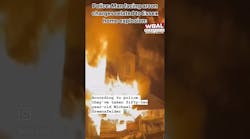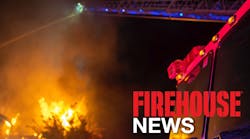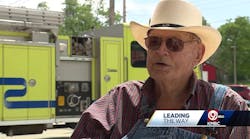Part 41
Sometimes, it's the little things that count. With all of the activities surrounding the fire service — response to alarms, training, physical fitness, meetings, staffing plans and budget reviews — it is difficult at times to step back and look at the big picture.
Apparatus design and specification writing can be a daunting task, especially if you are not familiar with the process or have not recently purchased a new apparatus. Learning what is standard equipment with each manufacturer and how it interfaces with the available options takes time and, at best, can be confusing with all of the other tasks at hand. When studying new apparatus design, it is sometimes best to just concentrate on the small items that can make the job safer, make it easier to conduct required tasks and make the training component straightforward. With this in mind, we are going to discuss several design innovations that can make all of these things happen.
In the "The Apparatus Architect" series, we have often discussed the importance of having engine company equipment such as adapters and fittings readily available for use and properly mounted on the apparatus. You don't need to have a full-height compartment with a pull-out tool board to accomplish this task. The Bedford, VA, Fire Department operates a short-wheelbase pumper that incorporates a pull-out tray with an angled shelf to hold the necessary fittings and adapters in a small, compact location. The design for this hardware came from the department and was a cost-effective way to mount the appliances.
One of the primary responsibilities of the engine company is to provide a reliable and continuous water supply on the fireground. As some departments use four-way valves on supply lines for hydrant operations, the size of this valve can create mounting problems, particularly on short-tailboard apparatus. The Bel Air, MD, Volunteer Fire Company set up each of its three pumpers with the hydrant valve stored inside of the rear body compartment while having the five-inch supply line pre-connected to the valve. This was accomplished by having the manufacturer provide a notch in the compartment floor to enable the supply line to pass under the door seal when the door is in the closed position. The department used plastic poly angles to secure the valve inside the compartment as well as providing mounting space for a tailboard step gun and other supply line fittings.
The Harrisburg, PA, Fire Department operates three engines and three tower ladders from four stations to protect the capital city. Harrisburg's engine companies are set up to operate with limited staffing with multiple pre-connected attack lines and heavy stream appliances. The department recently placed into service a 2008 Pierce Arrow XT pumper that is equipped with 10 pre-connected lines, including six crosslay lines ranging from 150 feet to 250 feet in length as well as two-inch and 2½-inch attack lines with a tailboard-mounted step gun.
The apparatus was designed to have the attack lines positioned low to the ground to reduce the opportunity for slips and falls. This was accomplished by using an L-shaped 500-gallon water tank and minimizing the use of fold-down steps to access hose. The crosslay beds are protected by heavy-duty netting released by pulling on a single Velcro strap that can be reached from the ground. The standpipe packs are carried in a tray below the ground ladders, which enables personnel to carry the hose without having to climb up on the engine. A reinforced steel bumper protects the apparatus with a swivel front suction inlet and trashline located at the front bumper. Much thought was put into the design of Wagon 3 with emphasis on simplicity and safety for the operating personnel.
Engine company operations can often be inhibited when the location of the fire is a greater distance than the longest available pre-connected attack line. For this reason, bulk hosebeds or backstretch hosebeds are necessary to enable engine company personnel to stretch and advance hoselines deep into buildings or into courtyards to provide sufficient hose to reach the objective. Bulk hosebeds or backstretch hosebeds are also necessary to give ladder company apparatus adequate room for optimum positioning, enabling engine company apparatus to be located farther from the fire building, but still have operational effectiveness. Harrisburg Wagon 3 carries a bulk bed of three-inch hose that can be used as leader line to provide this capability. The Kentland, MD, Volunteer Fire Company carries a backstretch bed of attack line connected to a bed of 2½-inch hose that can be deployed rapidly to provide an attack line for long stretches.
The position and location of handrails, fixed steps and scene lighting on apparatus is critical to ensure the safety of operating personnel. If you have the choice between providing a fold-down-style step or fixed step on your apparatus, go with the fixed-step wherever possible. When locating steps, position a non-slip handrail of an appropriate size and adequate lighting to illuminate the area. The Round Hill Community Fire and Rescue Company in Frederick County, VA, operates a well-designed unit that is equipped with a full-width rear step and intermediate step to access the hosebed. The department incorporated telescopic lighting at the rear body, where full-length light poles are provided with a non-slip gripping surface and double as handrails.
These are just a few examples of departments that have carefully thought through their operations and how they could enhance firefighter safety and operations in an efficient and cost-effective manner. Your engine company must be proficient in advancing all types and sizes of handlines as well as deploying all appliances, tools and equipment from the apparatus. Fire apparatus are a lot like tool boxes — the more tools and variety of tools that the apparatus carry, the more able they are to do the job that is required. It may be time to look at your apparatus and consider a "safety spring cleaning" to ensure that you are operating at peak efficiency.
TOM SHAND, a Firehouse® contributing editor, is a 33-year veteran of the fire service and works with Michael Wilbur at Emergency Vehicle Response, consulting on a variety of fire apparatus and fire department master-planning issues. He is employed by Seagrave Fire Apparatus LLC as a regional sales manager. MICHAEL WILBUR, a Firehouse® contributing editor, is a lieutenant in the New York City Fire Department, assigned to Ladder Company 27 in the Bronx, and has served on the FDNY Apparatus Purchasing Committee. He consults on a variety of apparatus-related issues around the country. For further information, access his website at www.emergencyvehicleresponse.com.





